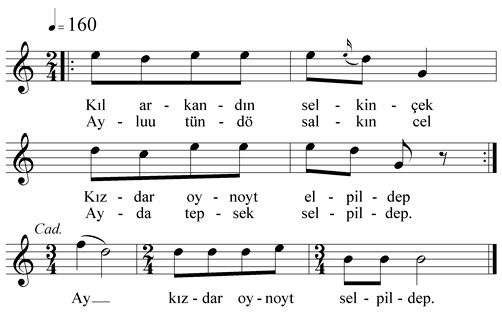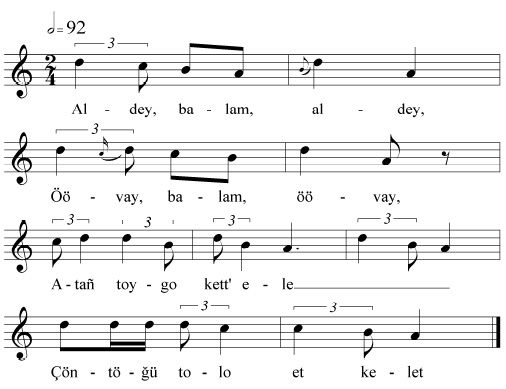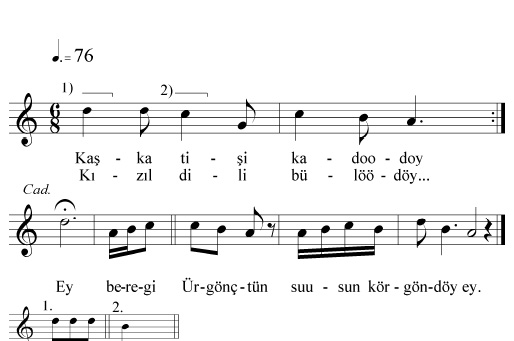- 1. Twin-bar tunes (ex.1-11, №1-58)
- Twin-bar tunes based on the g,-c bichord
- Twin-bar tunes based on rotating motifs
- Twin-bar tunes with descending/hill-shaped lines
- Motifs with a downward leap at the end of the line
- Motivic processes
- 2. Tunes moving on Ionian scales (ex.12-24, №59-164))
- Laments and their relatives
- Two-lined tunes of Major character with higher main cadences and their four-lined relatives
- Four-lined tunes of Major character
- 3. Aeolian tunes (ex.25-36, №165-238)
- Laments and related tunes
- Aeolian tunes with higher main cadence
- Four-lined tunes of Minor character
- Valley-shaped, ascending or undulating first line
- 4. Caramazan religious tunes (ex.37-41, №239-326)
- 5. Tunes of domed structure (ex.42-43, №327-332)
1.4. Motifs with a downward leap at the end of the line (ex.8, №41-50)









1.4.1. C-G, downward leap at the end of the line (ex.8a-b, №41-47). In Kyrgyz folk music the line-ending C-G, leap downward and the line-starting G,-C leap appear to be more popular than in many other folk musics. This downward leap at the end of the line may take the D-G, or D-B-G, forms as well. One of the simplest examples of the C-G, line end is ex.8a played on the kiyak. The same line ending can be seen in the Selkinçek tune of ex.8b, but the tune itself closes with a Phrygian formula. As seen earlier, too, it is not exceptional in Kyrgyz folk music to have tunes close with cadential sequences differing in several features from the main tune. In this group, for example, the lines closing on G, terminate with a cadential sequence ending on C (№41, 44-47).
1.4.2. A line ending with a D-A fifth leap or D-B-A (ex.8cd, №48-50). This line ending also occurs in Aeolian twin-bar tunes, but the first part of a line lies lower than in similar Ionian tunes (e.g. D-C-B-A| D A). Tunes of this kind can also be found among the Anatolian boğaz havasıs (throat songs), and are exceptional in the equally non-pentatonic Anatolian musical realm. I included here tunes of Minor character consisting of short convex lines in which the C-G, leap occurs (ex.8d).
a)

b)

c)

The rest of the twin-bar tunes do not coalesce into coherent groups and are so few in number that they can be disregarded here.
1 ex.8a, Song on kıyak, Bakıt Čıtırbayev (35), 1999, Bishkek, Çüy, coll. of D. Somfai Kara; ex.8b, Swing song (Selkinçek), Döölötova Nurbübü (1926), Çerik-Düyşömbü, Kazıbek, 2002; ex.8c, Lullaby, Kıdıraliyeva Alma (1919), Çerik, At-Başı, 2004; ex.8d, Fragment from the epic Manas (Taybuurul), Dıykanov Iymanakun (1914), Azık, Ak-Car, 2004

